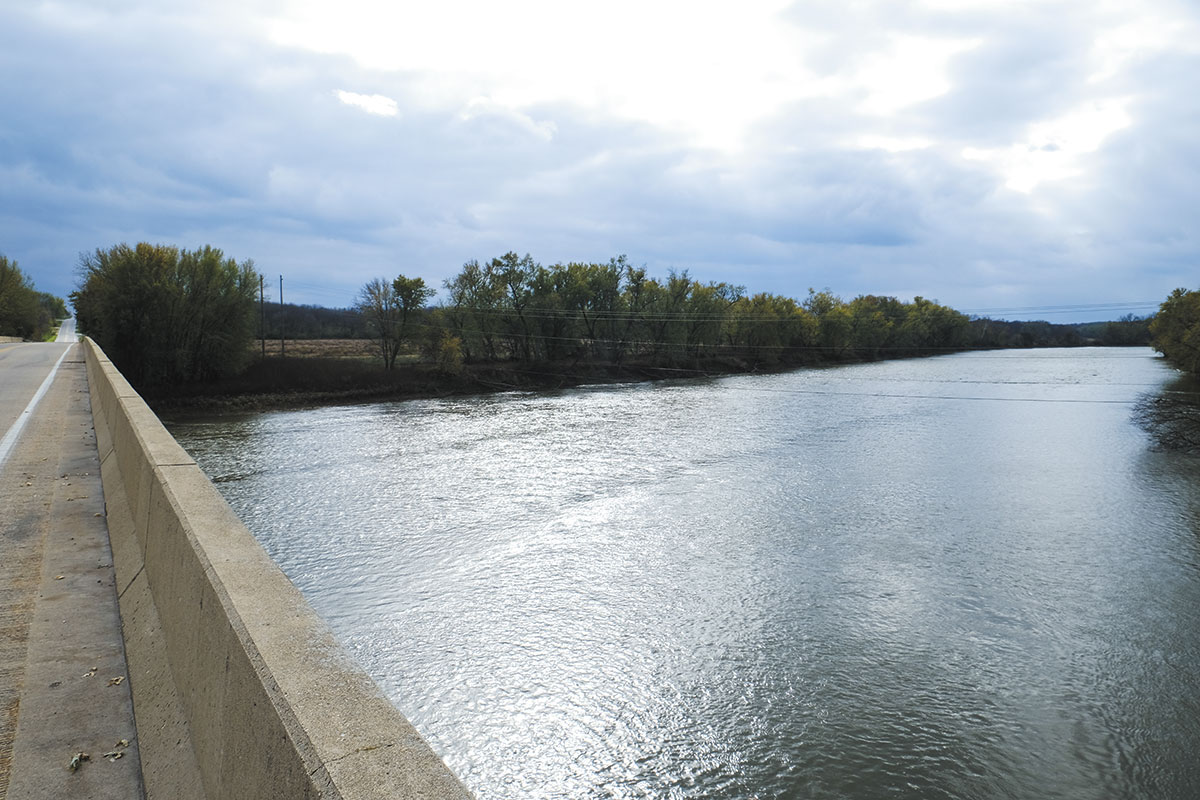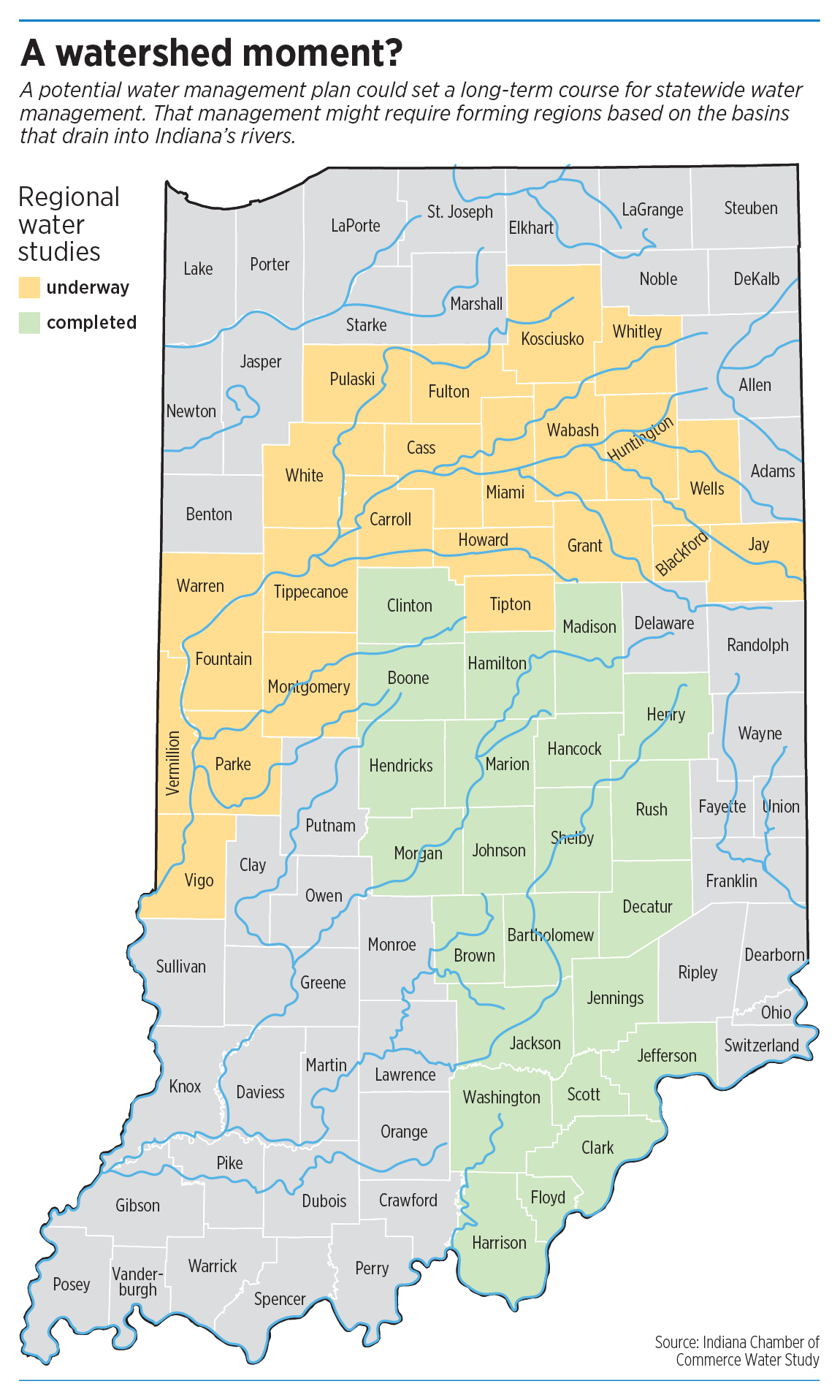Subscriber Benefit
As a subscriber you can listen to articles at work, in the car, or while you work out. Subscribe Now
Finding a water supply for an innovation and research park in Boone County has caused headaches for state economic development leaders, but the project’s growing pains have kick-started conversations about statewide water management that many say are overdue.
State officials, business leaders and other stakeholders say failing to act soon could threaten Indiana’s growth and economic development.

Prompted by the water troubles associated with the LEAP Research and Innovation District in Lebanon, state lawmakers are preparing to debate state water policy reform in next year’s legislative session, and many are hoping for action.
“There is a strong interest in getting this right,” Sen. Spencer Deery, R-West Lafayette, said at the White River Alliance’s 2024 Indiana Water Summit last month in Indianapolis. “Most of my colleagues understand that as we pursue industry [requiring] large amounts of water, that we have to start asking this question, because the water is not evenly distributed throughout the state.”
A new report from the Indiana Chamber of Commerce warns Indiana could end up in a water bind if it puts off planning. Because of the time it takes to build infrastructure, said Jack Wittman, study project leader, the problem needs to be addressed soon or some parts of the state could face potentially severe deficits.

“We have to start thinking like the Western states now,” Indiana Treasurer Daniel Elliott said at a recent meeting of the Indiana Finance Authority, noting that water is more heavily regulated there to take into account regional needs and the impact of potentially heavy usage.
The water challenges at the Indiana Economic Development Corp.’s LEAP District are an example of the kind of problems that could become commonplace.
The project requires outside water supplies because Boone County doesn’t have sufficient sources to support long-term plans for the 9,000-acre campus, but the wider region doesn’t have a water shortage. Thus, two pipeline projects to the district have been proposed.
The state’s ambitious economic development district seeks to land more advanced manufacturing businesses, such as microelectronics and life sciences, which tend to be water-intensive. More such projects are expected nationwide because of an increase in federal funding.
“It is essential to understand the risks and trade-offs associated with the economic cost of action versus the ecological cost of inaction to allow stakeholders to develop an understanding of their future, prioritize water use, and develop strategies to conserve water,” the chamber report said.
‘Overdue’ policy

Lawmakers and developers often use the word “overdue” when describing Indiana’s lack of a comprehensive water-management plan. Rep. Chris Campbell, D-Lafayette, said the lack of regulation has created a “free-for-all.”
“Any discussion of water policy in Indiana starts with a blank slate,” Rep. Ed DeLaney, D-Indianapolis, said in a statement to IBJ. “We don’t have time to wait for the courts. The question is how much time it would take the Legislature to do the job.”
A report from the 2023 Indiana Water Summit says the state’s policy is disconnected from water’s significance to the state’s future.
Indiana, like many Eastern states, follows the “riparian doctrine,” which allows a landowner whose property is adjacent to a river or above an aquifer to use any water that flows through that land.
In 1985, the Indiana General Assembly enacted the state’s first water-rights law, which was designed to protect owners of small-capacity wells from the effects of large-scale water withdrawals by other landowners.
The statute requires withdrawals of at least 100,000 gallons of water per day to be registered with the Department of Natural Resources within three months of the pumping.
Residents whose wells are affected by large water withdrawals have a right to timely compensation. The well owner can submit a written complaint to DNR, which will conduct an on-site investigation.
If the complaint is found to be credible, the DNR director can declare a groundwater emergency and ensure that “timely and reasonable compensation” is provided to residential well owners.
The chamber report concluded that the state can no longer afford to have a policy that only triggers agencies to react once a problem occurs. This could lead to situations where water deficiencies aren’t discovered until investments are already in progress, it says.
“Water governance has not kept pace with the needs of the developers and users in the state,” the report says. “There continues to be open-ended questions about the impact of new uses on regional water availability.”
House Speaker Todd Huston and President Pro Tem Rod Bray did not respond to two emailed requests for comment on whether water policy would be a priority next session or, if so, what that legislation will look like.
Indiana’s variety of water sources, availability and challenges from north to south mean no one-size-fits-all plan could be applied statewide, experts say.
And experts and studies say the state lacks the data needed to develop informed policy regarding water availability and levels, future water demand, climate change impacts, environmental flows, and water quality.
A state agency or department would also need to take the lead in guiding an expanded water policy. The Indiana Finance Authority is a top option since it already conducts water studies and has seen its role in a similar capacity expanded by legislation several times.
Today, other agencies are also involved, like DNR, the Indiana Department of Environmental Management and the Indiana Utility Regulatory Commission.
The Bloomington-based Conservation Law Center warns that spreading authority across so many agencies could create inefficiencies and regulatory gaps.
Regional input
Most stakeholders are seeking a regional approach to water management, with the state providing financial support and a broad framework with which to create regional plans.
Recent reports and studies emphasize that any statewide plan must start with local engagement.
Such an approach, combined with more transparency, could help avoid some of the objections that erupted over the IEDC’s exploration of a 35-mile pipeline to transfer up to 100,000 gallons of water a day from Wabash River aquifers in the Lafayette area to the LEAP district in Boone County.
Lafayette residents want assurances that such a project won’t compromise their own water needs. The IFA is analyzing the issue as part of a broader water study.
One of the leading statewide policy ideas is that, instead of creating the plan itself, the state would create the infrastructure and produce the data needed for regional committees to develop priorities.
This approach was pioneered by Texas, with Illinois and Minnesota adapting it in the Midwest.
Some believe Minnesota might have the system most applicable to Indiana. The state is divided into regions based on its four primary watersheds. Each region enters a 10-year planning cycle where it discusses local implementation, monitoring and assessment, water-resource characterization, problem investigation, protection strategies, and watershed management.
Regional water supply planning committees—composed of the public, local officials, industry, utilities and environmental groups—guide local efforts to establish priorities and make recommendations.
Those efforts culminate in a routinely updated state plan that reflects the will of the regions. It also can include inventories of water availability, an assessment of current and future water use demands and trends, assessments of resource management alternatives, and proposed methods of implementing recommended actions.
Clear statutory mandates, investments in data and funding are critical to such a plan, said Jason Moeckel of the Minnesota Department of Natural Resources. Planners also need to realize that change in water policy comes slowly, he said.
Funding a plan
A major question legislators will likely discuss at length in next year’s legislative session, if they decide to create a state water-planning system, is how it would be paid for.
The chamber report says the funding conversation might be difficult because imposing taxes to fund such efforts has long been an unpopular idea.
Some possible avenues include allocating a lump sum to an agency to finance water projects, upping utility fees for federal reservoir withdrawals or directing a small percentage of sales tax to a water fund.
Several lawmakers said persuading constituents to buy into a new water policy will be a lot of work, but the stage is being set as water-focused task forces continue to meet, new water studies are expected to be released over the next few months, and interest groups, such as the Indiana Farm Bureau, poll members for input.
Deery said the Legislature must work with the next governor in order to make significant progress on the issue.
“I think the General Assembly craves strong leadership on big challenges like this from the executive branch,” he said. “So I struggle to believe that we could get there without having an incoming governor really taking the lead on this.”
Deery and Campbell said government leaders must be transparent throughout the process to gain Hoosiers’ trust, especially following criticism of the LEAP District’s rollout.
DeLaney, who has been a staunch critic of LEAP’s rollout, said the district’s water woes provoked a number of important questions, including whether eminent domain would be used for a pipeline or if the state would pay a high price tag for more land as it has done for the district thus far.
“A confluence of challenges is before us,” he said in a statement. “We need to develop a water law, provide for a coordinated response to our water needs, revisit what industries we choose to support, and prevent mistakes such as those made in the LEAP projects.”
But state and business leaders also hope the water problems associated with LEAP have demonstrated the need for a statewide policy, guided by regional water plans.
“The public now sees that failure to properly plan for increasing demands in growing parts of the state may create significant water supply challenges,” the chamber report says. “The discussion has started; we must continue it.”•
Please enable JavaScript to view this content.


“The chamber report says the funding conversation might be difficult because imposing taxes to fund such efforts has long been an unpopular idea.” – Protecting our #1 natural resource costs money? Impossible!
The Chamber understands that the Republican supermajority thinks that the solution to every problem is “cut taxes and eliminate regulations”. Raising taxes and regulating water is the exact opposite, so guess the likelihood.
“We have to start thinking like the Western states now“. The Western states have drained the Colorado River. I don’t think we ought to follow that lead.
The Western and Plains states have been moving water across their states to supply cities and farms for generations now. So too has New York. And even in my lifetime in Indiana, crop irrigation has become much more of a thing…increasing demand on groundwater.
We do need water quantity regulation in Indiana. (We’ve had water quality regulation for 30+ years.)